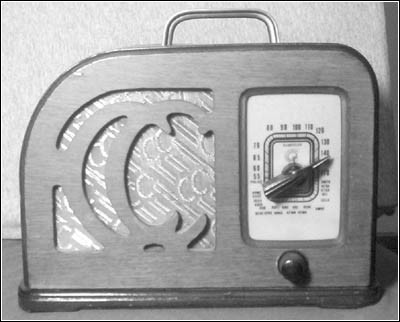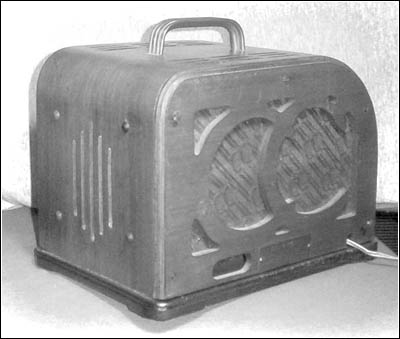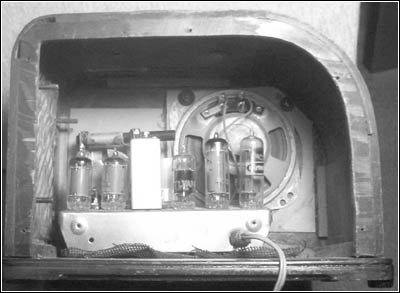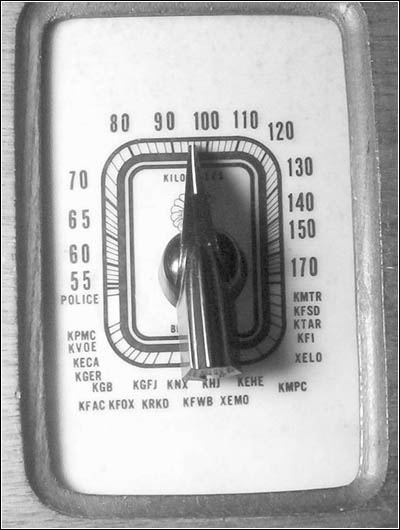Of Old Radios And Related Items--Published Monthly
American Carrier Call Corporation
Intercom ConversionBy Ed Ripley
WEB EDITION
Ed Ripley tells us about a happy marriage. He installed a 5-tube radio in an intercom cabinet and produced an unusual Art Deco radio. (Editor)
Over the years I kept seeing these very cool looking Art Deco intercom units at flea markets and antique shows. They were made by American Carrier Call Corporation of New York. Every time I saw one I would think, "Why couldn't it be a radio?" Why indeed! Finally, I gave in and bought one. Obviously it was part of a system, and it wasn't much good by itself. So I committed the unpardonable sin. I replaced the intercom guts with a small tube-type radio chassis. The completed conversion is shown in Figure 1.
Figure 1. The results of marrying an American Carrier Call Corp. intercom cabinet an Invicta 5-tube AC/DC chassis and a Troy dial scale.The style of the case called for something that would be "right hand drive." In other words, it needed to have the tuning capacitor on the right side. Luckily, all the front controls of the original intercom were located in a rectangular panel, which meant I didn't have to match a lot of shaft holes. However I did have to find some kind of dial that would fit the 21/2" x 31/4" opening. In the junk box I located a celluloid dial from an old Troy receiver. It was a simple piece of printed celluloid with one hole in the center for a tuning shaft to come through. It was a simple matter to glue it to the inside of the cabinet. Next I found a fairly long black pointer knob, the generic kind of pointer that's used on a lot of test equipment. I still needed a chassis, however, and until I found one, I wouldn't know where the on-off-volume would go.
After a lot of trial and error, I found a little Invicta 5-tube AC/DC AM chassis from one of those late '50s Japanese receivers. By raising the chassis a bit, (sort of like on stilts) I could get it to line up with the hole in my Troy dial. The only logical place for the volume control seemed to be the area just below the dial opening. By lowering the control about 3/4" and mounting it at the very bottom of the chassis, I was able to make it work. Since I already was raising the chassis from the floor of the cabinet, I was able to mount the volume control where it would protrude a little below the chassis base. A hole was drilled into the wood cabinet, just 21/4" below the dial shaft, and about 1/2" below the bottom of the dial opening. Figure 4 shows a rear view of the chassis and speaker in place.
Figure 2. This rear view of the intercom shows two of the three possible mounting positions for the speaker.The speaker was a little easier to manage. As Figures 2 and 3 (see print version) show, I had a choice of mounting it in the front, the right side or the back, as all three had openings and grille cloth. For the sake of better sound, I selected a 4-inch PM speaker to replace the tiny one that came with the Invicta chassis, and mounted it to the inside front of the cabinet.
At this point, I must confess to one mistake. The original plan was to mount the speaker to the right side, and I drilled holes for the rosette-head machine screws. Later, that arrangement proved to be too crowded for the chassis, so I used the ornamental screws to cover my mistake, and mounted the speaker facing the front. This time the front panel was thick enough that I could use short wood screws and mount from the inside.
Figure 4. A rear view of the cabinet with the Invicta chassis and the speaker in place.As Figure 5 shows (see print version), there were already vent holes in the bottom of the intercom cabinet, so I didn't have to drill any new ones to mount the Invicta chassis. The composite radio sounds quite respectable. Using the larger speaker greatly improved the sound quality of the chassis over the original Invicta. The dial doesn't quite track as true as I'd like, but with a little judicious positioning of the pointer, it reads with reasonable accuracy over most of the band. A close-up of the dial and tuning knob is shown in Figure 6. You'll notice, too, that the old Troy dial is "stationized." Since Troy was a California manufacturer, all the station call letters are from the West.
The end result is that I now have a late 1930s Art Deco cabinet housing a late '50s tube-type AM radio.
Figure 6. The dial scale from the Troy radio includes West Coast call signs.I really like the asymmetrical look with the sloping left side, the brass carry handle and the interesting grille cut-outs. If you look closely, you'll see that they read "C C" for Carrier Call. The original grille cloth also has the "C C" trademark pattern.
The main components used are: American Carrier Call intercom unit. Type I-3C cabinet; Troy celluloid radio dial; Invicta 5-tube AM chassis; generic black knob and pointer knob; 4-inch PM speaker, (possibly from an old GE clock radio)
(Ed Ripley, 230 Stanley Ave., South St. Paul, MN 55057)
Ed Ripley has been an avid enthusiast of old radios for more than two decades, and collects Art Deco receivers from the 1930s and 1940s. He is a retired radio broadcaster, and spent 30 years as a deejay, talk show host and program manager for stations in Tampa, Jacksonville, New Orleans, Cleveland, Rochester, and Minneapolis-St. Paul. He is a past-president of the Northland Antique Radio Club, of which he was one of the founders.
| [Free Sample] [Books, etc., For Sale] [Subscribe to A.R.C./Renew] [Classified Ads] [Auction Prices] [Event Calendar] [Links] [Home] [Issue Archives] [Book Reviews] [Subscription Information] [A.R.C. FAQ] URL = http://www.antiqueradio.com/Aug05_Ripley_Carrier.html Copyright © 1996-2005 by John V. Terrey - For personal use only. Last revised: June 27, 2005. For Customer Assistance please contact ARC@antiqueradio.com or call (866) 371-0512 toll free
Antique Radio Classified |



